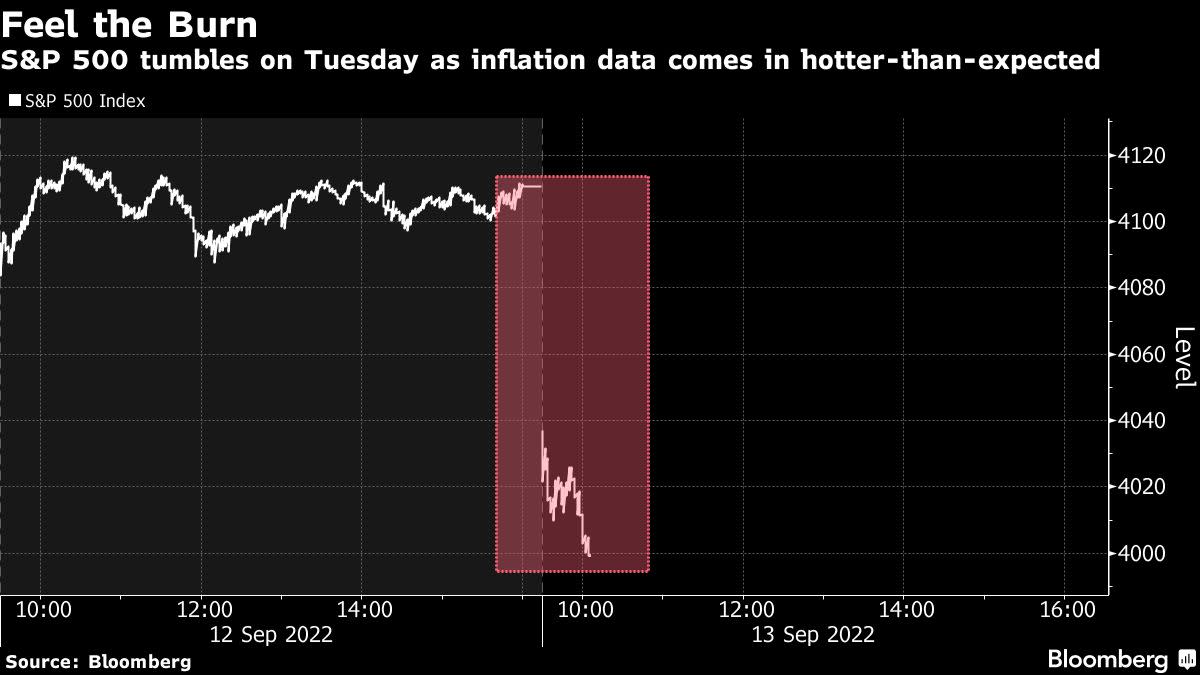
(Bloomberg) — Investors, analyst and economists alike received a harsh reality check on Tuesday as inflation for the month of August topped expectations and sent US stocks tumbling by the most more than two weeks.
The S&P 500 Index slumped as much as 2.7%, putting it on track to snap its longest winning streak in more than two months, while the tech-heavy Nasdaq 100 Index sank 3.6%. Stocks had rallied in recent days as economists anticipated Labor Department data would show another sizable deceleration in US consumer price growth. Instead, the consumer price index increased 0.1% from July and fell less than expected versus the same period last year.
In response to the hotter-than-anticipated inflation print, traders boosted bets for another 75 basis-point rate hike at next week’s Federal Open Market Committee meeting. While some Federal Reserve officials had voiced support for another outsized increase prior to a release of the data, the swaps markets had yet to fully price in such a move.
Here’s what Wall Street is saying about the August inflation data and what it means for equity markets:
Matt Peron, director of research at Janus Henderson Investors
“The CPI report was an unequivocal negative for equity markets. The hotter than expected report means we will get continued pressure from Fed policy via rate hikes. It also pushes back any ‘Fed pivot’ that the markets were hopeful for in the near term. As we have cautioned over the past months, we are not out of the woods yet and would maintain a defensive posture with equity and sector allocations.”
Quincy Krosby, chief global strategist at LPL Financial
“This report ensures that the Fed moves with a 75 basis point hike on September 21. The market has been expecting inflation, both headline and core readings, to ease but despite gasoline prices pulling back inflation ticked higher in August.”
John Lynch, chief investment officer at Comerica Wealth Management
“The journey from 9.0% CPI YOY to 7.0% should be relatively smooth given gas prices and the money supply. However, the trip from 7.0% to 5.0% could prove more challenging, with Fed tightening and higher market interest rates likely lasting longer than the consensus currently anticipates. As a result, we continue to question market moves like yesterday, where optimism about ‘peak inflation and peak Fed’ drive growth and technology higher.”
Guillermo Hernandez Sampere, head of trading at asset manager MPPM GmbH:
“It’s been a reality check. Markets were, again, ahead of themselves. The Federal Reserve will not step on the brakes before year end, so we can expect more rates hikes.”
James Athey, investment director at Abrdn:
“The recent bounce in equities looked incredibly ill-judged and premature. That CPI number is very strong relative to consensus and will not be what the Fed wanted to see at all. The chance of the pace of hikes slowing after September has receded somewhat as a result of this data but of course the reality is that what happens in Q1 2023 is still very much an open question.”
Cliff Hodge, chief investment officer at Cornerstone Wealth
“Unfortunately for markets this print will reinforce the need for the Fed to remain aggressive and will likely keep a lid on risk assets over the foreseeable future.”
Sebastien Galy, senior macro strategist at Nordea Asset Management:
“The US equity market was simply overly optimistic, whereas European equity markets are far far cheaper which gives them some resilience faced with this type of shock.”
Mark Hamrick, senior economic analyst at Bankrate:
“The prices for necessities continue to fuel this fire, including shelter, food, and medical care. The substantial decline in gasoline prices is noteworthy but doesn’t address the overall problem with inflation.”
Charlie Ripley, senior investment strategist at Allianz Investment Management
“It’s becoming more apparent to market participants that the amount of tightening from the Fed thus far has not been enough to cool the economy and bring down inflation. As a result, the Fed is likely going to need to bring the policy rate well above 4% to achieve their mandate of stable prices. Given the data string we have witnessed in recent weeks, we are expecting a substantial change in the Fed’s dot plot from the June meeting and investors should brace for higher rates for a longer period of time.”
Ipek Ozkardeskaya, senior analyst at Swissquote Bank:
“Good news is, inflation in the US gives signs of easing. Bad news is, inflation in the US doesn’t ease as much as investors would like it to, and core inflation accelerated stronger than expected.
Today’s figures are read as a guarantee of a 75bp hike next week, and probably 50bp or plus the month after.”
Danni Hewson, financial analyst at AJ Bell:
“Prices that have been bubbling over take time to cool and markets have been a little over enthusiastic in the last few days about the prospect of less aggressive rate hikes from the Fed in the near future. The reality is that whilst most things seem to be going in the right direction, there are still significant headwinds when it comes to things like electricity and gas supplies and simply keeping a roof over people’s heads. Realistically, there’s nothing in today’s figures to convince central bankers to switch tack and looking at rate hike probabilities 86% still expect a 75 basis point hike in the coming days.”
Esty Dwek, CIO at Flowbank SA:
“This probably comforts the Fed in hiking 75bp, but we are still nearing the end of its tightening cycle. However, they will stay higher for longer, so no pivot is coming. For markets, this is not as good as expected, but in any case, there was still a long way to go before markets & the Fed can feel that inflation will continue to fall.”
©2022 Bloomberg L.P.